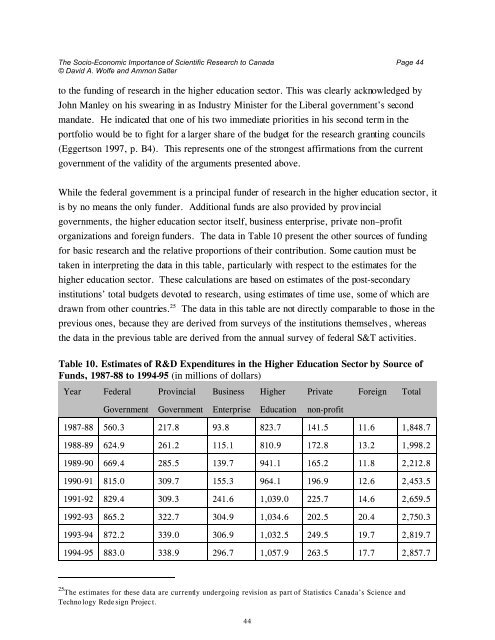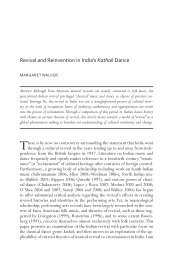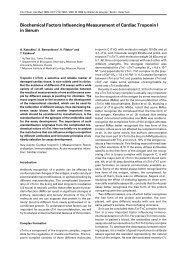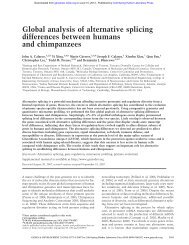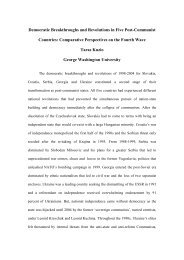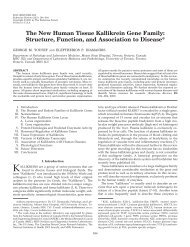The Socio-Economic Importance of Scientific Research To Canada
The Socio-Economic Importance of Scientific Research To Canada
The Socio-Economic Importance of Scientific Research To Canada
You also want an ePaper? Increase the reach of your titles
YUMPU automatically turns print PDFs into web optimized ePapers that Google loves.
<strong>The</strong> <strong>Socio</strong>-<strong>Economic</strong> <strong>Importance</strong> <strong>of</strong> <strong>Scientific</strong> <strong>Research</strong> to <strong>Canada</strong> Page 44© David A. Wolfe and Ammon Salterto the funding <strong>of</strong> research in the higher education sector. This was clearly acknowledged byJohn Manley on his swearing in as Industry Minister for the Liberal government’s secondmandate. He indicated that one <strong>of</strong> his two immediate priorities in his second term in theportfolio would be to fight for a larger share <strong>of</strong> the budget for the research granting councils(Eggertson 1997, p. B4). This represents one <strong>of</strong> the strongest affirmations from the currentgovernment <strong>of</strong> the validity <strong>of</strong> the arguments presented above.While the federal government is a principal funder <strong>of</strong> research in the higher education sector, itis by no means the only funder. Additional funds are also provided by provincialgovernments, the higher education sector itself, business enterprise, private non–pr<strong>of</strong>itorganizations and foreign funders. <strong>The</strong> data in Table 10 present the other sources <strong>of</strong> fundingfor basic research and the relative proportions <strong>of</strong> their contribution. Some caution must betaken in interpreting the data in this table, particularly with respect to the estimates for thehigher education sector. <strong>The</strong>se calculations are based on estimates <strong>of</strong> the post-secondaryinstitutions’ total budgets devoted to research, using estimates <strong>of</strong> time use, some <strong>of</strong> which aredrawn from other countries. 25 <strong>The</strong> data in this table are not directly comparable to those in theprevious ones, because they are derived from surveys <strong>of</strong> the institutions themselves, whereasthe data in the previous table are derived from the annual survey <strong>of</strong> federal S&T activities.Table 10. Estimates <strong>of</strong> R&D Expenditures in the Higher Education Sector by Source <strong>of</strong>Funds, 1987-88 to 1994-95 (in millions <strong>of</strong> dollars)Year Federal Provincial Business Higher Private Foreign <strong>To</strong>talGovernment Government Enterprise Education non-pr<strong>of</strong>it1987-88 560.3 217.8 93.8 823.7 141.5 11.6 1,848.71988-89 624.9 261.2 115.1 810.9 172.8 13.2 1,998.21989-90 669.4 285.5 139.7 941.1 165.2 11.8 2,212.81990-91 815.0 309.7 155.3 964.1 196.9 12.6 2,453.51991-92 829.4 309.3 241.6 1,039.0 225.7 14.6 2,659.51992-93 865.2 322.7 304.9 1,034.6 202.5 20.4 2,750.31993-94 872.2 339.0 306.9 1,032.5 249.5 19.7 2,819.71994-95 883.0 338.9 296.7 1,057.9 263.5 17.7 2,857.725 <strong>The</strong> estimates for these data are currently undergoing revision as part <strong>of</strong> Statistics <strong>Canada</strong>’s Science andTechnology Rede sign Project.44


